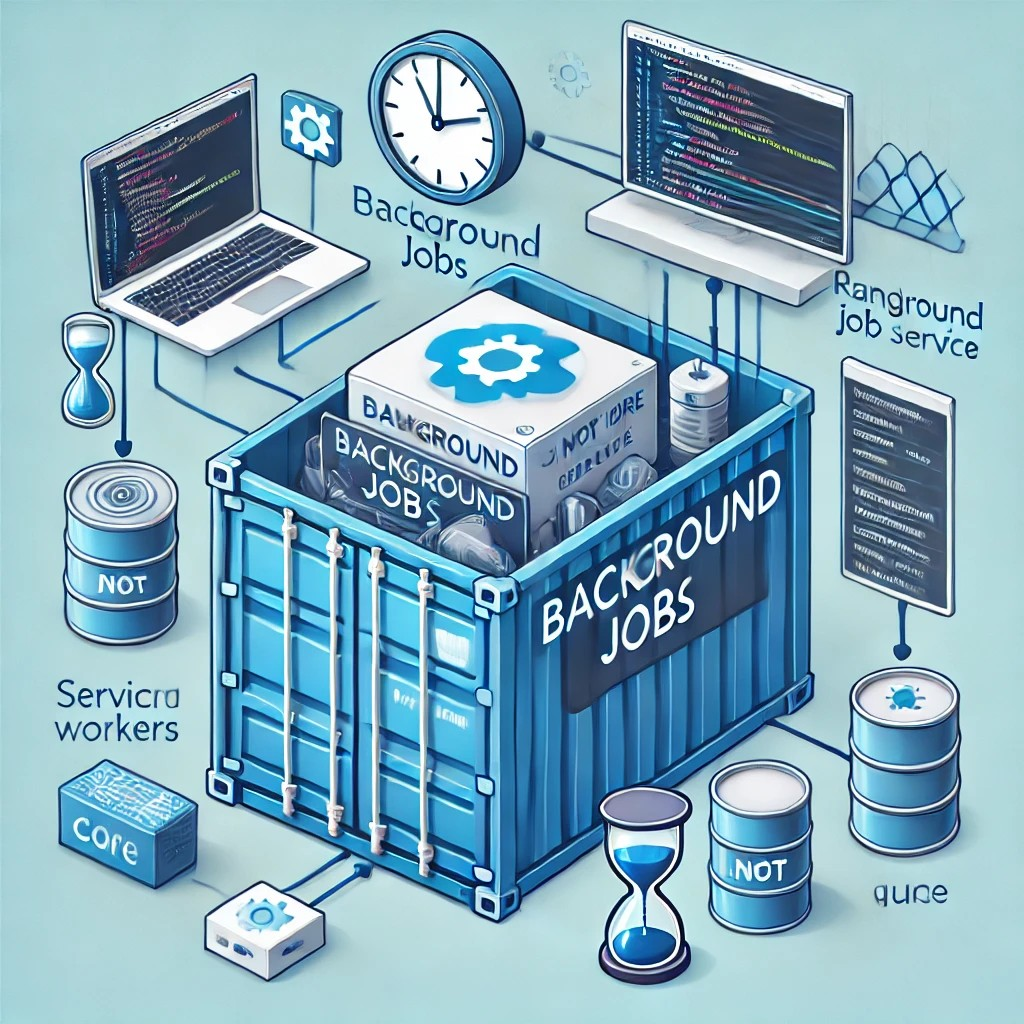
Running Background Jobs in Containerized Apps
Ensuring that a critical background task executes reliably and efficiently in a distributed environment is a complex challenge. A common pitfall is allowing multiple instances of the same task to run simultaneously, which can lead to data inconsistencies, resource contention, and unexpected behavior.
The Scenario:
I recently faced this challenge while developing a highly scalable microservice application built with .NET Core 8.0 and deployed to Azure Kubernetes Service (AKS). The background service, scheduled to run hourly, required a strict guarantee that only one instance was active at a time, regardless of the number of deployed replicas.
The Solution:
To address this challenge, I explored several approaches and ultimately implemented a robust solution. In this post, I’ll delve into the various strategies I tested, the challenges I encountered, and the final solution that ensured the reliability and integrity of my background service.
The Challenge
Here was my situation:
- A .NET Core web application running in Docker containers
- A background job that needs to run every hour
- Multiple replicas running in AKS clusters
- Need to ensure the job runs in exactly one container
Attempt #1: The Naive Approach - Just Add a Background Service
My first thought was simple - just create a BackgroundService in .NET Core. Here’s what I tried:
public class HourlyJobService : BackgroundService
{
protected override async Task ExecuteAsync(CancellationToken stoppingToken)
{
while (!stoppingToken.IsCancellationRequested)
{
await DoWork();
await Task.Delay(TimeSpan.FromHours(1), stoppingToken);
}
}
}
The problem? It ran in every container! 😅 Multiple jobs running simultaneously - definitely not what we wanted.
Attempt #2: Distributed Lock with Redis
Next, I thought - “Aha! I’ll use Redis to implement a distributed lock!”
public class HourlyJobService : BackgroundService
{
private readonly IDistributedLockManager _lockManager;
protected override async Task ExecuteAsync(CancellationToken stoppingToken)
{
while (!stoppingToken.IsCancellationRequested)
{
var lockAcquired = await _lockManager.TryAcquireLockAsync("hourly-job-lock", TimeSpan.FromMinutes(5));
if (lockAcquired)
{
try
{
await DoWork();
}
finally
{
await _lockManager.ReleaseLockAsync("hourly-job-lock");
}
}
await Task.Delay(TimeSpan.FromHours(1), stoppingToken);
}
}
}
This worked better, but had some issues:
- What if the process crashed while holding the lock?
- Redis became a single point of failure
- Lock duration needed careful tuning
Attempt #3: Leader Election with Kubernetes
This is where things got interesting. Kubernetes has a built-in leader election mechanism using ConfigMaps or Leases. Here’s how I implemented it:
public class KubernetesLeaderElectionService : BackgroundService
{
private readonly IKubernetes _kubernetes;
private readonly string _podName;
private readonly string _namespace;
protected override async Task ExecuteAsync(CancellationToken stoppingToken)
{
var leaseClient = _kubernetes.CoordinationV1Namespaced(_namespace);
while (!stoppingToken.IsCancellationRequested)
{
try
{
// Try to acquire or renew the lease
var lease = await leaseClient.CreateOrUpdateLeaseAsync(
"background-job-lease",
new V1Lease
{
Spec = new V1LeaseSpec
{
HolderIdentity = _podName,
LeaseDurationSeconds = 15
}
},
stoppingToken);
if (lease.Spec.HolderIdentity == _podName)
{
// We are the leader, do the work
await DoWork();
}
}
catch (Exception ex)
{
// Handle errors, maybe we lost leadership
_logger.LogError(ex, "Error during leader election");
}
await Task.Delay(TimeSpan.FromMinutes(1), stoppingToken);
}
}
}
The Final Solution: Combining Leader Election with Background Jobs
After some iterations, I settled on a more robust solution that combines leader election with proper job scheduling:
public class LeaderAwareJobScheduler : BackgroundService
{
private readonly IKubernetes _kubernetes;
private readonly ILogger<LeaderAwareJobScheduler> _logger;
private readonly IJobExecutor _jobExecutor;
private bool _isLeader;
protected override async Task ExecuteAsync(CancellationToken stoppingToken)
{
// Start leader election process
_ = RunLeaderElectionAsync(stoppingToken);
// Schedule jobs only when leader
var timer = new PeriodicTimer(TimeSpan.FromHours(1));
while (await timer.WaitForNextTickAsync(stoppingToken))
{
if (_isLeader)
{
try
{
await _jobExecutor.ExecuteAsync(stoppingToken);
}
catch (Exception ex)
{
_logger.LogError(ex, "Error executing scheduled job");
}
}
}
}
private async Task RunLeaderElectionAsync(CancellationToken stoppingToken)
{
var leaderElector = new LeaderElector(_kubernetes, "background-jobs");
leaderElector.OnStartedLeading += () =>
{
_isLeader = true;
_logger.LogInformation("Started leading");
return Task.CompletedTask;
};
leaderElector.OnStoppedLeading += () =>
{
_isLeader = false;
_logger.LogInformation("Stopped leading");
return Task.CompletedTask;
};
await leaderElector.RunAsync(stoppingToken);
}
}
Why This Solution Works Best
-
Native Kubernetes Integration: Uses Kubernetes’ built-in features rather than introducing external dependencies
- Fault Tolerance:
- If the leader crashes, a new leader is automatically elected
- No orphaned locks to deal with
- Seamless container recreation
-
Scalability: Works the same whether you have 2 or 20 replicas
- Monitoring: Easy to track leadership changes through logs
Deployment Configuration
Here’s the Kubernetes deployment configuration I used:
apiVersion: apps/v1
kind: Deployment
metadata:
name: web-app
spec:
replicas: 3
template:
spec:
containers:
- name: web-app
image: your-image:tag
env:
- name: POD_NAME
valueFrom:
fieldRef:
fieldPath: metadata.name
- name: NAMESPACE
valueFrom:
fieldRef:
fieldPath: metadata.namespace
Lessons Learned
-
Start Simple: While the final solution might look complex, starting simple helped understand the real requirements
-
Use Platform Features: Kubernetes provides many building blocks - use them!
-
Consider Failure Modes: Always think about what happens when things go wrong
-
Monitor and Log: Make sure you can debug issues in production
Next Steps
If you’re implementing something similar, consider:
- Adding metrics for job execution
- Implementing retry policies
- Setting up alerts for leadership changes
- Adding health checks
Remember, there’s no one-size-fits-all solution. Your specific needs might require a different approach, but I hope this journey helps you make an informed decision!
Happy coding! 🚀
